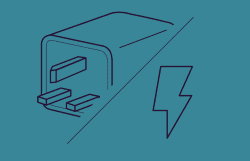At Energy Solutions, our team work’s extremely hard to ensure businesses are making the most of their energy.
We understand it can be stressful and overwhelming. However, with our help, you can trust that we will make your energy an asset that is worth knowing about. This guide will hopefully give you a clear knowledge about the energy industry.
How To Understand Energy Costs
We think it is important to understand how non-commodity costs (NCCs) are calculated. Especially how they may affect your energy expenditure. There has been a rise in NCCs in recent times, so here is a breakdown of how they work.
NCCs are separated into two categories:
- Government measures, such as levies, aim to reduce carbon emissions and ensure the security of supply.
- The charges and costs that come with operating the national grid.
So, how is the cost of energy is calculated? How much comes directly from the activities of energy suppliers? We’ve created this guide to help answer these questions for you.
There isn’t much energy suppliers can change about the NCCs themselves.
However, here at Energy Solutions, our aim is to guide you on how much you have to pay. This is to make sure you understand the costs, as well as ways you can reduce them and options that you can control.
What Government Schemes Are There?
Renewables Obligation (RO)
What Is The Renewables Obligation?
The main Government support scheme for large scale, renewable electricity generation in the UK is the RO. The RO is based on tradable Renewable Obligation Certificates, known as ROCs. Ofgem issues ROCs to eligible generators.
Electricity suppliers are required to source a certain level of their supply from renewable sources. This scheme will carry on until 2037.
How Are The Renewables Obligation Charged?
The UK Government sets the obligation levels each year. The size of each energy supplier’s obligation level is set based on the amount of electricity that they supply to their customers each year.
Energy suppliers are required to disclose their electricity sources. You can find these sources their ‘fuel mix’, usually found on their website.
Who Receives The Renewables Obligation Money?
If the ROC is bought from eligible generators, the RO can be met. However, an energy supplier is required to pay the equivalent amount into a buy-out fund if they do not have a sufficient number of ROCs to meet their set obligation.
The funds are then used to cover the administration costs of the scheme. Any surplus is then redistributed to the generators.
Feed-In-Tariff (FITs)
What Are Feed-in-Tariffs?
FITs are a scheme that aims to guide energy companies to install small-scale renewable and low carbon electricity generation of up to 5MW.
How Are Feed-in-Tariffs Charged?
Based on their share of the electricity market, FITs are paid by suppliers.
Who Receives The Feed-in-Tariffs Money?
Energy suppliers that have over 250,000 customers must pay a fixed tariff for the electricity produced by generators that are under the FITs scheme. This also includes any surplus electricity they export to the grid.
For energy suppliers that have less than 250,000 customers, they may voluntarily participate in the scheme. The FITs program has been capped by the UK government to a budget of £100m.
Contracts For Difference (CFDs)
What Are Contracts For Difference?
Created in 2013, CFDs were introduced to increase the development of new, low carbon generation in the UK such as renewables and nuclear energy. CFDs give revenues that guarantee a fixed price for each MWh that generators produce.
Every contract is a legal agreement between the Low Carbon Contracts Company (LCCC) and low carbon electricity generators.
How Are Contracts For Difference Charged?
It is funded by a compulsory levy on suppliers which is based on their market share of demand.
There are two parts, the operational cost levy that funds the day to day running of the scheme. There is also the supplier obligation costs that are a reflection of the amount of generation funded by the scheme.
Who Receives The Contracts For Difference Money?
If the fixed price that is received by the low carbon electricity generator falls below the wholesale reference price, it will be topped up by subsidy payments. However, if the price rises above the market average, the generator will pay back the difference.
Energy Intensive Industry (EII) Exemptions
Any customers that are working within EIIs will be compensated for some of the indirect costs of both the RO and FIT scheme.
EIIs that operate in an international market will therefore not have a competitive disadvantage due to renewable energy support costs.
Who Is Eligible?
- Customers with electricity costs that amount to 20% or more of their gross added value.
- Customers on a government list of defined EIIs.
Currently, EIIs are compensated for 85% of the cost of the RO and FIT scheme. However, the UK government has moved from a compensation scheme to an exemption.
What this means for EII customers is they will receive a rebate on their energy bill for the cost of these schemes, rather than receiving compensation at a later date.
Capacity Market
What Is The Capacity Market?
The Capacity Market is a UK government scheme that makes sure that the electricity system will stay secure with a sufficient and reliable capacity that can meet the demands set by the nation.
How Is The Capacity Market Charged?
The Capacity Market is funded by a supplier levy. The supplier levy consists of two elements:
- The operational cost levy – covering the cost of running the scheme,
- The supplier obligation levy – covering payments to generators.
But how is it calculated?
The supplier’s share of the levy is based on the market share they hold during periods of high demand, such as over the winter period.
Who Receives The Capacity Market Money?
There are two annual auctions and one held every four years that is in advance of the delivery date, with another being held one year in advance of the delivery date.
Power stations and storage owners will bid on the Capacity Market agreements.
Holders of Capacity Market agreements will then be expected to provide their agreed generation volumes, at times of system stress in return for a Capacity Payment.
Climate Change Levy (CCL)
What Is The Climate Change Levy?
The Climate Change Levy or CCL is a tax on electricity and gas that is used by businesses as well as public sector consumers.
The CCL is designed to increase energy efficiency with a reduction in greenhouse gas emissions. For more information about the CCL, you can visit www.gov.uk/green-taxes-and-reliefs/climate-change-levy
How Is The Climate Change Levy Charged?
The CCL is charged per kWh of energy used. It is index-linked, meaning there are different rates for both electricity and gas. You can find the CCL payment on your energy bill.
Who Receives The Climate Change Levy Money?
Energy suppliers will collect the CCL from customers, then forward it to HM Revenue and Customers.
EU ETS and Carbon Price Support
Electricity generators must pay for emitting carbon emissions through allowances that are set by national governments under the EU emissions trading scheme (EU ETS).
There is also the UK’s Carbon Price Floor (CPF). The CPF sets a rising carbon price trajectory, stimulating the investment in low carbon infrastructure. This will also discourage the carbon-intensive generation, including coal-fired power stations due to the cost of carbon increasing.
The Carbon Price Support (CPS) is used as a top-up tax which is levied on fossil fuels that have been used for electricity generation on top of the EU ETS price.
The CPS is set by HMRC two years in advance. It was introduced to make up the difference between the EU ETS and Carbon Price Floor. Currently, it is fixed at £18 per tonne of CO2 until 2021.
How Is The CPS Charged?
The CPS is part of the customers normal unit rate and is recovered by power station operators through the wholesale electricity price.
Pricing of the pass-through cost of carbon can change at any given time, based on the marginal plant on the electricity system setting the wholesale price.
Who Receives The CPS Money?
Both EU ETS and CPS receipts go to the UK Treasury.
Use of System Charges
Balancing Services Use of System (BSUoS)
What Are BSUoS Charges?
BSUoS charges cover the cost of the balancing of the electricity network. This makes sure the network operates with the perfect amount of electricity. Too much or too little can have huge impacts on the network, causing issues.
How Are BSUoS’s Charged?
BSUoS charges are calculated daily and paid by generators and suppliers.
Charges are non-locational and pay for the day to day balancing of the electricity system by National Grid plc.
Who Receives The BSUoS Money?
The National Grid is responsible for balancing supply and demand. They can increase and decrease the volume on the grid.
Transmission Network Use of System (TNUoS)
What Are TNUoS Charges?
The costs of installing and maintaining the electricity transmission system are what the TNUoS charges cover. This covers the areas of England, Wales, Scotland as well as offshore locations.
How Are TNUoS’s Charged?
Tariffs for TNUoS are set annually. They are split between generation and demand and there is a cap on the amount that can be charged to generation.
Also, there is a split between a locational charge as well as a residual charge.
Locational charges reflect the costs that customers impose on the transmission network to transport their electricity.
For customers, charges are calculated based on the type of meter they have:
- Half-hourly.
- Non-half hourly.
Who Receives The TNUoS Money?
The National Grid plc.
Distribution Use of System (DUoS)
What Are DUoS Charges?
DUoS charges cover the cost of operating the distribution networks that transport energy to the customer.
How Are DUoS’s Charged?
DUoS charges are set by each distribution company, so they will differ according to geographical location.
Each distribution company will also set three time-based price bands that are based on times of peak usage. They are:
- Red
- Amber
- Green
Gas Transportation Charges
Gas Transportation Charges account for around a third of your overall gas bill. They are adjusted twice a year and cover the costs of the National Transmission System (NTS) as well as the Gas Distribution Network (GDN).
Who Receives The DUoS Money?
DUoS is set by and paid to each regional distribution company.
AUG (Allocation of Unidentified Gas)
AUG charges pay for any gas that is lost. This can be through:
- Measurement errors.
- Unauthorised meters.
- Theft and more.
Unidentified gas is any gas that has entered the network but can’t be accounted for. This is after accounting for expected losses from leakage.



